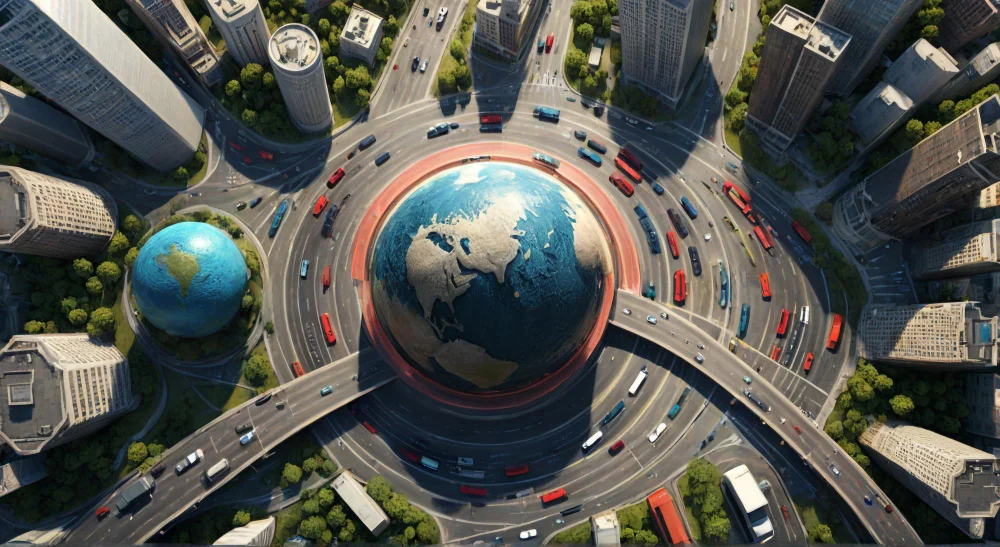China’s Belt and Road Initiative (BRI), often called the “New Silk Road,” is a transformative project designed to enhance global trade and build diplomatic bridges across continents. Launched in 2013, this ambitious plan aims to create an extensive network of infrastructure, connecting Asia with Europe, Africa, and beyond. The BRI reflects China’s commitment to reshaping trade routes, strengthening alliances, and expanding its influence on the global stage.
Overview of the Belt and Road Initiative (BRI)
The BRI involves two main components: the Silk Road Economic Belt and the 21st Century Maritime Silk Road. The land-based Silk Road Economic Belt links China with Europe through Central Asia, while the Maritime Silk Road connects Southeast Asia, South Asia, and Africa to Europe via sea routes. Together, these initiatives cover over 60 countries, aiming to boost trade by investing in infrastructure like railways, ports, and highways.
Historical Context and Inspiration
The BRI draws inspiration from the ancient Silk Road, a trade route that connected China to Europe and the Middle East. Centuries ago, this network facilitated the exchange of goods, ideas, and culture. The modern BRI seeks to revive this spirit, fostering a sense of shared prosperity and collaboration. For China, this initiative represents a way to strengthen its role as a central player in global trade.
Key Regions Involved
China’s Belt and Road Initiative impacts many regions, each with its unique role:
- Central Asia: Known as the heart of the Silk Road, Central Asia is crucial for connecting China with Europe. Countries like Kazakhstan and Uzbekistan have benefited from improved infrastructure and trade opportunities.
- South and Southeast Asia: Nations like Pakistan and Indonesia play vital roles as key ports and transport hubs. The China-Pakistan Economic Corridor (CPEC), a flagship BRI project, aims to enhance connectivity and economic development in the region.
- Europe: European countries such as Greece and Italy have joined the BRI to enhance trade ties with China. Ports in Greece, particularly the port of Piraeus, serve as critical gateways for Chinese goods entering Europe.
- Africa: The BRI has brought significant investments in African infrastructure, particularly in countries like Kenya and Ethiopia. New ports, highways, and railways have been built to strengthen trade routes with China.
Economic Impacts on Partner Nations
The BRI has been a game-changer for economies across Asia, Africa, and Europe. Here’s how it’s making an impact:
- Increased Trade: By improving infrastructure and connectivity, the BRI has made it easier and faster for goods to flow between countries. This has led to an increase in trade volume, benefiting both China and partner nations.
- Job Creation: Infrastructure projects under the BRI have generated jobs in various regions. Local workers are hired to build railways, ports, and roads, boosting local economies.
- Access to Financing: The BRI provides developing countries with access to Chinese investment and financing for large-scale projects. This has been a boon for nations that may have struggled to fund such projects independently.
Diplomatic Implications and Strategic Alliances
The BRI has allowed China to forge stronger diplomatic ties with countries across the globe. By investing in infrastructure and economic development, China has gained the trust and support of several nations, which could be pivotal in future geopolitical matters.
Strengthened Political Influence
Through the BRI, China has established itself as a leader in promoting economic development. Partner nations often view China as a reliable ally, enhancing its political influence in regions that were traditionally aligned with other major powers.
Strategic Partnerships
Countries participating in the BRI are more likely to align with China on international issues. For instance, some nations may support China in forums like the United Nations, reflecting a shift in global alliances.
Environmental and Social Considerations
The BRI’s rapid expansion has raised questions about its environmental and social impact. Some concerns include:
- Environmental Degradation: Infrastructure projects, such as roads and railways, often require clearing land and can lead to deforestation and habitat loss.
- Debt Concerns: Many developing nations rely on Chinese loans for BRI projects. While this has stimulated growth, it has also raised concerns about potential debt dependence on China.
- Social Displacement: The construction of large infrastructure projects may lead to the displacement of local communities. Efforts are being made to address these issues, but challenges remain.
Criticism and Challenges Facing the Initiative
Despite its benefits, the BRI faces several criticisms and challenges:
- Debt Trap Diplomacy: Critics argue that China’s loans may trap developing nations in debt, giving China leverage over their resources and strategic assets. Some countries have struggled to repay these loans, fueling concerns over dependency.
- Lack of Transparency: Critics point out that some BRI projects lack transparency in their financial dealings, leading to questions about corruption and governance in partner countries.
- Geopolitical Tensions: The BRI’s expansion has created friction with other major powers. The United States and several European countries have raised concerns that the BRI may give China undue influence, especially in strategically important regions.
Future Prospects of the BRI
Looking forward, the BRI’s future will depend on how it addresses both its challenges and opportunities. As China continues to expand its network of trade and investment, the BRI could evolve in several ways:
- Digital Silk Road: Beyond physical infrastructure, China is investing in digital projects, including fiber-optic networks and e-commerce, to support a “Digital Silk Road.” This may enhance connectivity in areas like telecommunications and internet access.
- Environmental Initiatives: In response to criticism, China has started incorporating green policies in its BRI projects, focusing on sustainable development and reducing the environmental impact of new infrastructure.
- Enhanced Global Collaboration: As the BRI continues to shape global trade and diplomacy, China may seek stronger collaborations with international organizations to increase transparency and win broader global support.
Conclusion
The Belt and Road Initiative is transforming global trade and diplomacy in ways the world hasn’t seen since the original Silk Road. As China invests in infrastructure across continents, it’s not just reshaping trade routes—it’s redefining international alliances and expanding its influence on the world stage. While the BRI presents opportunities for economic growth, it also faces criticism and challenges that could shape its future. In the end, China’s New Silk Road may pave the way for a more connected and interdependent world, but it will require careful navigation to balance its ambitions with the needs and concerns of its global partners.


